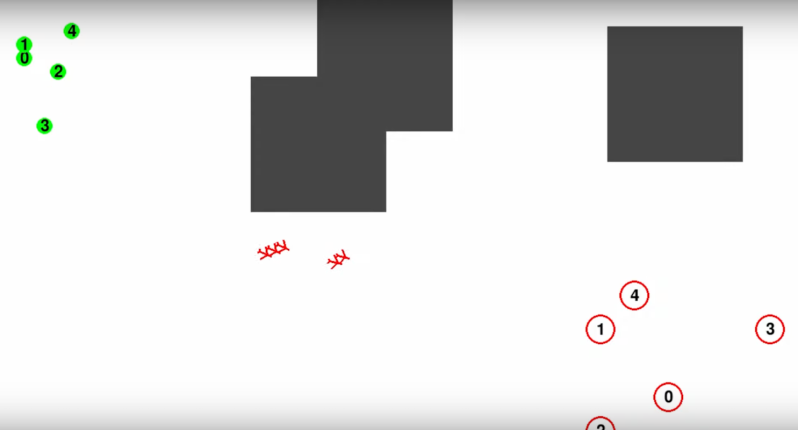Seeing airplanes fly in formation is an exciting experience at something like an air show, where demonstrations of a pilot’s skill and aircraft technology are on full display. But there are other reasons for aircraft to fly in formation as well. [Peter] has been exploring the idea that formation flight can also improve efficiency, and has been looking specifically at things like formation flight of UAVs or drones with this flight planning algorithm.
Aircraft flying in formation create vortices around the wing tips, which cause drag. However, another aircraft flying through those vortices will experience less drag and more efficient flight. This is the reason birds instinctively fly in formation as well. By planning paths for drones which will leave from different locations, meet up at some point to fly in a more efficient formation, and then split up close to their destinations, a significant amount of energy can potentially be saved.
[Peter] is using a modified version of the RRT* algorithm which generates nodes for viable flight paths, and then uses the various paths found to map out potential shared flight paths. Another consideration that had to be accounted for was the actual energy savings factor for the shared section of the flight paths. For birds it’s estimated that the energy savings is around 70%, but varying this amount even for idential simulations often yields surprising results. Even with only a 5% energy savings, the flight paths can change dramatically.
For now this idea exists mostly in the world of simulations, as UAVs and drones haven’t yet reached a critical mass where so many are flying around autonomously that these factors need to be taken into account. It’s certainly a viable future though as companies like Amazon look to automate more of their logistical processes, but this is only one of several ways to improve service and cut costs.

















I just assumed military tight formations were to decrease radar signature and disguise the number of aircraft. I would also guess the military has looked into this for strategic (less refueling etc) reason than economic, the latter of which is probably a secondary concern.
I would think that unless you absolutely had to do it to get home, the risk add would pretty much eradicate any advantage you’d get from saving fuel. A goose doesn’t really suffer much if it messes up in formation.
I always thought the flying in formation for drills and airshows thing was just for discipline or something, never really thought about it actually. Radar cross-section is a good guess
Speaking of getting home, see Robbie Risner who literally pushed an F-86 Sabre with his F-86 to get them out of enemy territory after they were shot through the fuel tank and lost power, and Pardo’s Push for an F4 pilot who did the same trick later, pushing another F4 by its tail hook. They went over 60 and 90 miles tandem like that before bailing out with parachutes.
Formation flying originated in WWI, when there was no radar. Military aircraft fly in close formation because of the decided advantages it gives them in combat.
As for passenger aircraft, nobody is doing or proposing close formation flights for anything other than photo opportunities with empty planes. Airbus did a demo flight between Toulouse and Montreal with 3 km spacing between two A350s. They’re also required to maintain vertical separation of at least 305 m. Estimated savings were in the 5% range.
The basic idea is to have transoceanic flights follow each other while over water, then split up to travel to their final destinations; e.g. flights from New York, Boston, Montreal and Toronto travelling to London, Dublin, Amsterdam, and Paris would cross the ocean as a group between, say, Newfoundland and Ireland. You could do similar things over the Pacific with planes flying out of Vancouver, Seattle, San Francisco and LA.
Do you know why Geese fly in a V Formation?..
It’s because the V Shape allows the Lead Goose to create a pressure wave that the Following Geese can Surf..
Do you why The V Formation has one side longer than the Other?..
Generally that is the Side with More Geese in it.. :)
And geese aren’t good at math.
When a duck messes up in formation it can lead to a big quack up… 😂
Also allows you to communicate via hand signals instead of radio, decreasing your signature in a tac setting. Generally don’t fly in super tight formation for long amounts of time because it places a super high task load on the wing(s).
“UAVs and drones haven’t yet reached a critical mass where so many are flying around autonomously that these factors need to be taken into account”
Please, no.
As the first bird gets no reduction of effort, when it get tired it slips to the end of the formation, being replaced by the one in the back. I have no knowledge if we decoded this algorithm.
With quadcopters, there is no such vertex and therefore you can’t expect any duel saving.
I was just about to bring up this exception with rotorcraft with respect to vortex efficiency and how they don’t have it. In fact, the greatest fluid influence is downdraft, which would need to be fought in a “trailing” aircraft, making close formation horribly inefficient.
Gliders sail on gossamer threads,
helicopters beat the air into submission.
Quads fly by making so much noise that the ground runs away from them.